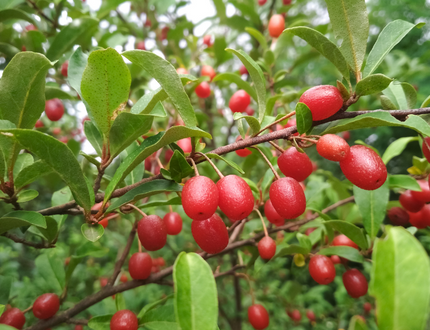Appreciating Goumi Berry
What’s that, you say? A Gummy Bear-y?!
Not quite. Unfortunately, we have yet to discover proof that our favorite gummy candies can be grown on trees, although that would be pretty amazing. We’re talking about the next best thing– this shrubby perennial from our edible landscaping section here at HOEC, which we think deserves greater notice and appreciation: Goumi Berry!
A Shrub of Many Names
Goumi Berry (Elaeagnus multiflora)— also known as Cherry Silverberry, Cherry Elaeagnus, Japanese Silverberry, Gumi, Daio-Gumi, and Natsugumi—is a deciduous, shrubby perennial native to China, Japan, Korea, and the Russian Far East. It is closely related to the edible ornamentals Autumn Olive and Silverthorn, but unlike its relatives, which are now regulated in some states as exotic invasive species, Goumi Berries are non-invasive and not currently regulated anywhere in the United States.
Ornamental, Fruiting Shrub, or Companion Plant?
The answer is…all three! The attractive foliage (dark green, with a silvery, shimmery underside), fragrant flowers, dangling red fruits, and the unfussyness of Goumis make them an interesting and unusual addition to any food forest, edible landscape, ornamental garden, or home orchard.
In mid-spring, Goumi Berry shrubs produce a proliferation of small, cream-colored, attractively bell-shaped, fragrant blooms whose scent some liken to lilac. By early to mid- summer, these give way to ½-inch-long, intensely red drupes speckled all over with silvery scales. When picked unripe or partially ripe, their flavor is astringent and mildly acidic. When fully ripe, the fruits have a sweet-tart flavor reminiscent of rhubarb, which lends itself nicely for use in pies, tarts, jams, jellies, preserves, syrups, fruit leather, and wine. Each fruit contains a single fibrous seed. At optimal ripeness the fruits have a soft, juicy texture enveloped by a thin, fragile skin, resulting in a rather short shelf life– thereby hindering their popularity as candidates for commercial cultivation and transport. For the home orchardist or gardener, however, they are a beautiful, nutritious, and eye-catching addition!
NUTRITION
Like many of our brightly-colored fresh fruits and berries, Goumi Berries are highly nutritious, and are notable sources of Vitamins A, C, E, and flavonoids. They are also high in lycopene, a powerful antioxidant good for heart health. Although fibrous and a bit difficult to eat (read: chewy!), the seeds of Goumi Berries are indeed edible and have been found to be high in essential fatty acids— rather unusual for a fruit!
Goumis can be eaten fresh off the shrub, but most find their tart flavor best suited to baking, processing, or preserving.
SOIL HEALTH
Planting Goumis has a secondary benefit, too, which is their ability to improve soil health through nitrogen-fixation. Many species in the Elaeagnus genus have evolved symbiotic relationships with root-zone inhabiting actinobacteria, which gather nitrogen from the atmosphere and then release it back into the surrounding soil in bio-available forms. This directly feeds the host plant, and to a certain extent indirectly benefits plants nearby by generally improving the quality of poor, nutrient-depleted soils.
This makes the Goumi Berry a great companion plant. In orchards, it can be intercropped with young fruit trees— aka, planted in partial shade just outside of your fruit tree’s drip line. Intercropping can be utilized as a way to diversify crops, maximize space while young fruit trees reach maturity, and attract pollinators.
Growing Your Own
CULTIVATION
Goumis are tough. They can be grown from USDA Hardiness Zones 4-9 and survive cold temperatures as low as -20F. They prefer well-drained soils and locations with at least 6 hours of sun a day, but are generally noted for tolerating a wide range of soil conditions, as well as their shade tolerance, drought resistance, and the fact that they are relatively unbothered by pests and disease. Goumis are partially self-fertile and will produce fruit without a partner, but fruit size and yield are typically maximized by planting another Goumi variety nearby for cross-pollination. Goumis have a sturdy, upright growth habit, and if left to their own devices most can grow upwards of 15 feet. With regular pruning they can be kept to more manageable sizes of 9 or 10 feet.
PROPAGATION
Goumi Berries can be propagated from seed or from cuttings. Seed germination is slow and a bit finicky, requiring 4 weeks of warm stratification followed by 12 weeks of cold stratification; as such, Goumi Berries are most commonly propagated from cuttings. Well-established new plants propagated from cuttings can begin producing fruit in 3-4 years. Plants grown from seed can begin producing fruit in 3-10 years. “Sweet Scarlet,” “Red Gem,” and “Carmine” are popular cultivars noted for their heavier yields and larger, tastier fruits.
Want to learn more about caring for these and other under-appreciated fruit-bearing oddities? Join us at the Home Orchard Education Center as a volunteer, or sign up for one of our many Workshops for some hands-on learning! We hope to see you soon.














